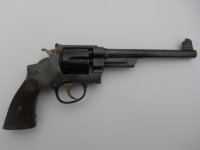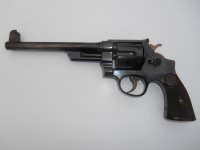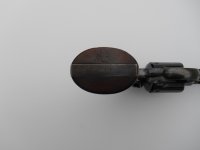Regarding the ".45 Special" cartridge, about all I have found is from "History of Modern U. S. Military Small Arms Ammunition" by Hackley, Woodin, and Scranton. The cartridge was referred to as the "Cal. 45 Ball, Model of 1906," however there was no "official" nomenclature assigned to it, as it was a purely an experimental cartridge made for use in the 1906-1907 Army Board trials. It was developed at Frankford Arsenal beginning in 1905, and had a rimmed case 0.923" in length, a 230 grain cupronickel jacketed bullet (drawings show a hemispherical nose), and used 7.2 grains of Bullseye powder. The FA drawing number was 47-3-18. The only headstamp known is F A 4 06. Measured specimens differ slightly from the drawing dimensions. An initial test lot was produced at FA in January 1906 (size of lot not given), and 10,000 rounds were ordered by the Ordnance Office. Cases were made during April 1906 and were loaded and released in July 1906. Ordnance records indicate that both cannelured and un-cannelured cases were manufactured, and one specimen was observed having a cannelured case and three stab crimps near the case mouth. A cannelure, when present, is at the base of the seated bullet.
Dimensions given in the drawing: Rim Diameter - 0.533"; Head Diameter - 0.473"; Neck Diameter - 0.473"; Bullet Diameter - 0.453"; Case Length - 0.923"; Overall Cartridge Length - 1.3". As earlier stated, measurements of actual cartridges differ from the drawing dimensions. For example, the measured bullet diameter is 0.451".
During the Board trials, there was a problem with a high misfire rate from the FA-manufactured ammunition. There is some indication that, as a result, commercially-manufactured ammuniton without headstamps was also used.
To me, it seems that the .45 Model of 1906 cartridge is what was later referred to as the ".45 Special" and ".45 Frankford."
---------------------------------
Regarding the Model 1909 .45 cartridge, I have two Colt M1909 revolvers. I fire them with mild .45 Colt reloads (the cases having the small-diameter rim), and can verify that extraction difficulties occur. I have had a few instances in which the extractor slipped around the rim of a partially-withdrawn fired .45 Colt case during extraction. Just something to be aware of for most of us, but it could be catastrophic were it to happen during a combat reload while the Juramentados were attacking the ramparts.









